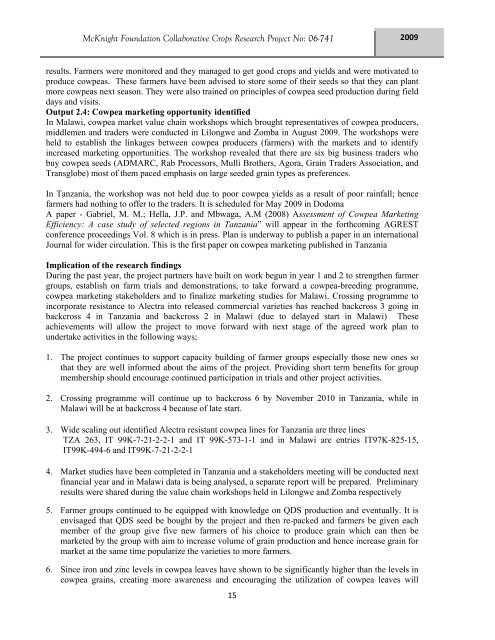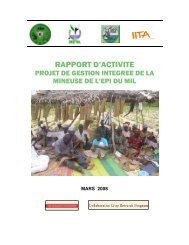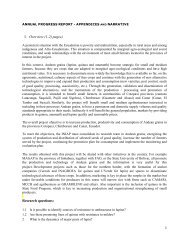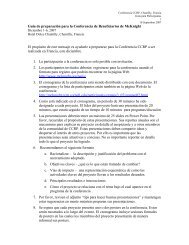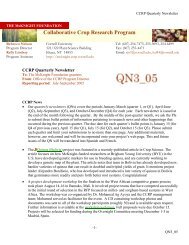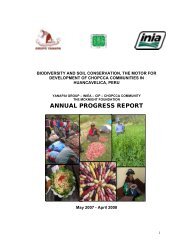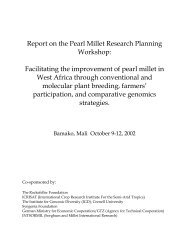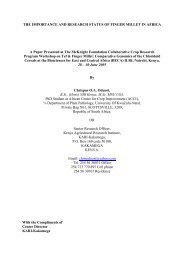English - McKnight Foundation Collaborative Crop Research Program
English - McKnight Foundation Collaborative Crop Research Program
English - McKnight Foundation Collaborative Crop Research Program
You also want an ePaper? Increase the reach of your titles
YUMPU automatically turns print PDFs into web optimized ePapers that Google loves.
<strong>McKnight</strong> <strong>Foundation</strong> <strong>Collaborative</strong> <strong>Crop</strong>s <strong>Research</strong> Project No: 06-741<br />
results. Farmers were monitored and they managed to get good crops and yields and were motivated to<br />
produce cowpeas. These farmers have been advised to store some of their seeds so that they can plant<br />
more cowpeas next season. They were also trained on principles of cowpea seed production during field<br />
days and visits.<br />
Output 2.4: Cowpea marketing opportunity identified<br />
In Malawi, cowpea market value chain workshops which brought representatives of cowpea producers,<br />
middlemen and traders were conducted in Lilongwe and Zomba in August 2009. The workshops were<br />
held to establish the linkages between cowpea producers (farmers) with the markets and to identify<br />
increased marketing opportunities. The workshop revealed that there are six big business traders who<br />
buy cowpea seeds (ADMARC, Rab Processors, Mulli Brothers, Agora, Grain Traders Association, and<br />
Transglobe) most of them paced emphasis on large seeded grain types as preferences.<br />
In Tanzania, the workshop was not held due to poor cowpea yields as a result of poor rainfall; hence<br />
farmers had nothing to offer to the traders. It is scheduled for May 2009 in Dodoma<br />
A paper - Gabriel, M. M.; Hella, J.P. and Mbwaga, A.M (2008) Assessment of Cowpea Marketing<br />
Efficiency: A case study of selected regions in Tanzania” will appear in the forthcoming AGREST<br />
conference proceedings Vol. 8 which is in press. Plan is underway to publish a paper in an international<br />
Journal for wider circulation. This is the first paper on cowpea marketing published in Tanzania<br />
Implication of the research findings<br />
During the past year, the project partners have built on work begun in year 1 and 2 to strengthen farmer<br />
groups, establish on farm trials and demonstrations, to take forward a cowpea-breeding programme,<br />
cowpea marketing stakeholders and to finalize marketing studies for Malawi. Crossing programme to<br />
incorporate resistance to Alectra into released commercial varieties has reached backcross 3 going in<br />
backcross 4 in Tanzania and backcross 2 in Malawi (due to delayed start in Malawi) These<br />
achievements will allow the project to move forward with next stage of the agreed work plan to<br />
undertake activities in the following ways;<br />
1. The project continues to support capacity building of farmer groups especially those new ones so<br />
that they are well informed about the aims of the project. Providing short term benefits for group<br />
membership should encourage continued participation in trials and other project activities.<br />
2. Crossing programme will continue up to backcross 6 by November 2010 in Tanzania, while in<br />
Malawi will be at backcross 4 because of late start.<br />
3. Wide scaling out identified Alectra resistant cowpea lines for Tanzania are three lines<br />
TZA 263, IT 99K-7-21-2-2-1 and IT 99K-573-1-1 and in Malawi are entries IT97K-825-15,<br />
IT99K-494-6 and IT99K-7-21-2-2-1<br />
4. Market studies have been completed in Tanzania and a stakeholders meeting will be conducted next<br />
financial year and in Malawi data is being analysed, a separate report will be prepared. Preliminary<br />
results were shared during the value chain workshops held in Lilongwe and Zomba respectively<br />
5. Farmer groups continued to be equipped with knowledge on QDS production and eventually. It is<br />
envisaged that QDS seed be bought by the project and then re-packed and farmers be given each<br />
member of the group give five new farmers of his choice to produce grain which can then be<br />
marketed by the group with aim to increase volume of grain production and hence increase grain for<br />
market at the same time popularize the varieties to more farmers.<br />
6. Since iron and zinc levels in cowpea leaves have shown to be significantly higher than the levels in<br />
cowpea grains, creating more awareness and encouraging the utilization of cowpea leaves will<br />
15<br />
2009


